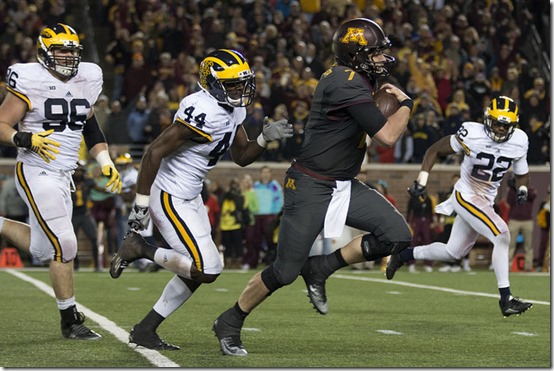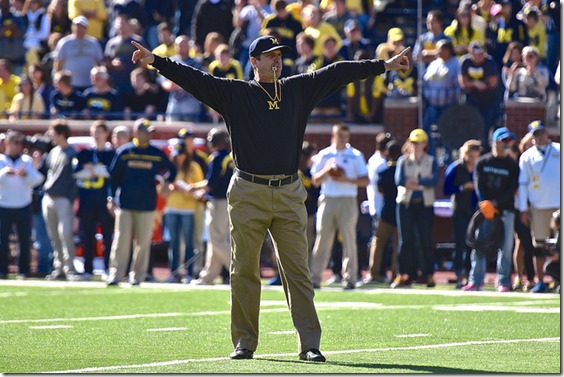Moving the (Stati)Sticks: Week Nine

[Barron/MGoBlog]
Well, that was weird. Mitch Leidner, who Greg Jackson said wasn’t the same after a knee injury, did what’s pictured above while also passing for about four games worth of yardage against this secondary on a number of throws that just sort of dropped from the heavens. Minnesota fans had no problem pointing out just how bizarre this game was. Here’s a portion of the intro from The Daily Gopher’s piece on charting the game:
Minnesota received both gifts and sorrow. While clock management at the end doomed the team, Michigan should have picked off Leidner twice. Both times would have prevented touchdowns.
When they start that second sentence with a negative I expect the part after the comma to be exuberantly positive, and it is but in a really odd, we-barely-made-this-competitive sort of way. Their quarterback threw two how-are-those-not-interceptions that were only avoided because of some mystical combination of a holiday, a night game, a piece of crockery, and a Harbaugh. Their fans saw that as something worth celebrating, which seems overly punitive but is also an indicator of just how not used to having nice things they are.
The stats aren’t going to do anything to lessen the sting for Minnesota; they basically back up The Daily Gopher’s self loathing. Minnesota outgained Michigan significantly and put up more unexpected explosive plays than any other team M has faced this year. They had double the scoring opportunities Michigan did, an extra drive, and managed to run 10 more plays. Minnesota mixed spectacularly lucky plays with some that were just plain spectacular and still lost. For 58 minutes and 41 seconds they got gifts; for 19 seconds, the kind of sorrow that steals a little bit of your football soul and can only be made incrementally better by trying to rationalize how it could have been so much worse.
[After THE JUMP: Four Factors. Five Factors. Tables. A goofy Harbaugh picture]
The Mathlete’s Four Factors:
Once again, a quick reminder of what the factors mean:
Conversion rate = [1st Downs gained]/[1st Down plays (including first play of drive)]. A three and out is 0/1. A one play touchdown is 1/1. Two first downs and then a stop is 2/3, etc.
Bonus Yards = [Yards gained beyond the first down line]/[Total plays from scrimmage]
This is an adjustment to how I have previously calculated, to account for the plays a team runs.
Field Position = The expected point difference per game for where a team’s offense starts and where a team’s defense starts. Each drive is given an expected value based on the start of scrimmage, all of the drives for the offense and defense are totaled and compared. This accounts for all elements of field position: turnovers, special teams, drive penetration etc.
Red Zone: Points per red zone trip (TD’s counted as 7 regardless of PAT)
Offense:
| Field Pos. | Conv. Rate | Bonus YPP | Red Zone | |
| Week 1 | 21.0 | 73 | 1.52 | 5.7 |
| Rank | 60 | 30 | 59 | 27 |
| Week 2 | 25.0 | 68 | 1.63 | 5.8 |
| Rank | 77 | 70 | 95 | 30 |
| Week 3 | 25.3 | 70 | 2.56 | 5.8 |
| Rank (B1G Rk) | 84 (12) | 54 (6) | 43 (6) | 30 (5) |
| Week 4 | 24.5 | 72 | 2.92 | 5.8 |
| Rank (B1G Rk) | 91 (14) | 30 (4) | 31 (3) | 27 (4) |
| Week 5 | 26.9 | 67 | 2.78 | 5.8 |
| Rank (B1G Rk) | 59 (10) | 54 (3) | 39 (3) | 20 (2) |
| Week 6 | 28.2 | 68 | 2.93 | 5.8 |
| Rank (B1G Rk) | 41 (4) | 39 (1) | 25 (2) | 21 (2) |
| Week 7 | 28.4 | 65 | 2.75 | 5.5 |
| Rank (B1G Rk) | 36 (4) | 61 (5) | 36 (3) | 31 (2) |
| Week 9 | 27.6 | 65 | 2.59 | 6.1 |
| Rank (B1G Rk) | 45 (6) | 51 (3) | 44 (6) | 3 (1) |
Defense:
| Field Pos. | Conv. Rate | Bonus YPP | Red Zone | |
| Week 1 | 27.9 | 73 | 1.64 | 5.7 |
| Rank | 47 | 44 | 20 | 30 |
| Week 2 | 25.1 | 67 | 1.60 | 6.1 |
| Rank | 51 | 58 | 23 | 88 |
| Week 3 | 24.0 | 63 | 1.28 | 6.1 |
| Rank (B1G Rk) | 35 (4) | 38 (6) | 9 (3) | 100 (13) |
| Week 4 | 23.1 | 59 | 1.23 | 6.1 |
| Rank (B1G Rk) | 29 (5) | 17 (4) | 4 (1) | 110 (13) |
| Week 5 | 24.5 | 55 | 1.10 | 6.1 |
| Rank (B1G Rk) | 32 (4) | 7 (2) | 1 (1) | 115 (13) |
| Week 6 | 23.6 | 54 | 1.01 | 6.1 |
| Rank (B1G Rk) | 21 (4) | 6 (1) | 1 (1) | 115 (12) |
| Week 7 | 23.4 | 57 | 1.24 | 6.4 |
| Rank (B1G Rk) | 20 (3) | 6 (1) | 1 (1) | 124 (13) |
| Week 9 | 23.4 | 60 | 1.54 | 4.6 |
| Rank (B1G Rk) | 17 (3) | 7 (2) | 6 (2) | 42 (6) |
The offensive stats pass the eye test. Michigan’s Field Position metric and Bonus YPP dropped, which isn’t much of a surprise. The drop was especially obvious in Bonus YPP; even when Michigan hit “big” plays they were between 13 and 16 yards (with one exception- a 22-yard rush by Chesson) and those big plays tended to come on passing downs. The longer ones tended to come on something like 2 and 8 and went for 13 yards; that’s only racking up five yards as far as Bonus YPP is concerned.
Conversion Rate stayed the same as it was after the Michigan State game. We’ll see in a minute that Michigan’s Success Rate in this game was pretty good; these two work in concert to show that Michigan was able to move the ball and stay in generally favorable situations. Red Zone went up a tick because Michigan scored when they got in the red zone (more on that later); bumping that stat is easier said than done.
Defensively, Conversion Rate and Bonus YPP going up shouldn’t come as much of a surprise. Minnesota drove the ball and hit Michigan for some improbably long completions; even so, Michigan’s still top 10 in both stats. The trend is a little concerning, but this is where the eye test pairs well with the numbers. What Minnesota did didn’t exactly seem replicable, and I’d expect these two stats to drop again this week. If they don’t we can probably hover over the panic button. Red Zone finally fell, and rather dramatically. Maybe something like, I don’t know, a goal-line stand helps. Maybe.
Advanced Box Score
Another game, another batch of stats tilted the wrong direction. Michigan’s offense fared a bit better than they did against Michigan State (up from 3.69 yards per play to 4.95), but the defense was even worse (5.59 against MSU, 6.23 against Minnesota), at least from the perspective of yards per play.
Michigan allowed Minnesota eight (!) scoring opportunities, which is double their four. Wait wait wait don’t pass out; keep in mind that Football Study Hall defines scoring opportunities as trips inside the 40, so we’re not talking about the red zone here. Still, woof. The silver bismuth lining is that Michigan only allowed 3.25 points per scoring opportunity, which you better do if you’re going to allow eight scoring opps on 12 drives. On offense, Michigan only managed four scoring opportunities but came away with 7.00 points per opportunity. Worth noting is that both teams had the same average starting field position, the 31.1 yard line.
One of the stats that points in the direction of Michigan’s defense giving up untimely big plays is Minnesota’s success rate, which was just 31%. Remember that success rate is the stayed-on-track stat, and then look at Minnesota’s 6.23 yards per play. Contrast that with Michigan’s 44% success rate and 4.95 yards per play and the way Minnesota moved the ball becomes clearer.
Five Factors
It was a particularly bad day for one of the defensive Five Factors, while others fared better than I expected. Explosiveness took a nasty tumble from 11th to 64th; Mike Zordich was not wrong when he said the secondary laid an egg. Michigan’s defensive Efficiency actually improved, jumping from sixth to second. The aforementioned 3.25 points per trip inside the 40 also happens to be what the defense is averaging on the season, which is fifth best in the nation.
Offensively, Michigan’s somewhere between middling and not great. They’re ranked 72nd in Explosiveness, 47th in Efficiency, and 53rd in Finishing Drives (averaging 4.98 points per trip inside the 40). Those values, and especially their profile as a non-explosive but functional offense, have stayed relatively close to the same as the season has gone on. FEI helps back this up: 75% of drives contain at least one first down (45th nationally) and Michigan has gained 46.4% of available yardage (52nd), but only 9.5% of drives have averaged 10 YPP (96th)
I’ve held off discussing this in case it changed but it hasn’t, so it seems the time to address turnovers has come. Michigan’s currently –4 on the season, but their expected turnover margin is 1.55. According to their statistical profile, bad turnover luck has cost them 3.47 points per game. If ever there was a set of stats that screams “this is definitely not 2011 in case you couldn’t tell from the absence of a horseshoe busting out of the back of someone’s khakis,” this is it.
Opponent’s Run Game: Still having a harder time gaining traction. In fact, Michigan’s numbers actually improved after the Minnesota game as they rose from fourth to second. Rushing Success Rate ranks a similarly impressive third, with the real problem being Rushing IsoPPP; the defense’s Opportunity Rate, a measure of how often the opposing O-line gets five yards for the runner, is just 27.7% (fifth nationally), yet their Rushing IsoPPP ranks 73rd. It seems that when they give up a run it’s a big one.
Michigan’s Run Game: is pretty mediocre right now. Their overall Rushing S&P+ is 26th, but their Rushing IsoPPP is 70th and Opportunity Rate is 90th at 36.7%. At least they can basically stay in good down-and-distance situations; Michigan is 38th in Rushing Success Rate.
Opponent’s Pass Game: Michigan was 11th overall and eighth in limiting big plays and now they’re 30th and 41st, respectively. A good night it was not. Not much else to say here.
Michigan’s Pass Game: Michigan’s Passing Success Rate took a small jump from 40.4% to 41.5%. Michigan couldn’t complete a ball more than 20 yards downfield and their Passing IsoPPP fell back and is now ranked 72nd. Michigan’s overall Passing S&P+ is 36th, and I know you might have a hard time believing this but that gives them an above average passing attack, albeit one that can’t complete deep balls.
Looking Forward, Looking Back:
Post-10/24 games, so you can see what happened during Michigan’s bye:
| Opponent | Off. S&P+ | Def. S&P+ | Overall S&P+ |
| @ Utah | 42 (-6) | 22 (-3) | 21 (-3) |
| Oregon State | 109 (-2) | 96 (+0) | 106 (-2) |
| UNLV | 113 (-1) | 86 (-2) | 103 (+0) |
| BYU | 30 (+16) | 47 (+2) | 41 (+10) |
| @Maryland | 90 (+8) | 60 (+8) | 81 (+6) |
| Northwestern | 110 (+4) | 7 (-1) | 50 (+4) |
| Michigan State | 27 (+7) | 38 (-6) | 27 (-1) |
| @ Minnesota | 100 (-4) | 31 (-3) | 62 (-2) |
| Rutgers | 57 (+0) | 118 (-2) | 100 (-8) |
| @ Indiana | 22 (-5) | 110 (-3) | 71 (-9) |
| @ Penn State | 63 (-2) | 32 (-10) | 45 (-10) |
| Ohio State | 13 (+3) | 11 (+3) | 5 (+0) |
| Michigan | 47 (+3) | 1 (+0) | 2 (+0) |
| Opponent | Off. FEI | Def. FEI | Overall FEI (includes Special Teams FEI) |
| @ Utah | 29 (-15) | 13 (-8) | 12 (-10) |
| Oregon State | 106 (+2) | 76 (+7) | 106 (+8) |
| UNLV | 105 (+7) | 104 (+4) | 99 (+1) |
| BYU | 26 (+1) | 61 (-2) | 35 (-1) |
| @Maryland | 84 (+16) | 79 (-5) | 89 (+9) |
| Northwestern | 87 (-5) | 6 (+4) | 31 (+8) |
| Michigan State | 11 (+2) | 30 (-3) | 14 (+0) |
| @ Minnesota | 108 (-12) | 19 (+10) | 79 (-1) |
| Rutgers | 59 (-20) | 109 (+0) | 93 (-27) |
| @ Indiana | 37 (-4) | 89 (-9) | 54 (-7) |
| @ Penn State | 98 (-18) | 18 (-1) | 59 (-3) |
| Ohio State | 21 (+12) | 11 (+9) | 9 (+3) |
| Michigan | 69 (-15) | 2 (+1) | 7 (+2) |
Here’s how things look after the Minnesota game:
| Opponent | Off. S&P+ | Def. S&P+ | Overall S&P+ |
| @ Utah | 43 (-1) | 21 (+1) | 24 (-3) |
| Oregon State | 110 (-1) | 92 (+4) | 104 (+2) |
| UNLV | 104 (+9) | 93 (-7) | 101 (+2) |
| BYU | 29 (+1) | 48 (-1) | 38 (+2) |
| @Maryland | 100 (-10) | 58 (+2) | 80 (+1) |
| Northwestern | 111 (-1) | 7 (nc) | 49 (+1) |
| Michigan State | 27 (nc) | 36 (+2) | 23 (+4) |
| @ Minnesota | 87 (+13) | 24 (+7) | 56 (+6) |
| Rutgers | 80 (-23) | 116 (+2) | 105 (-5) |
| @ Indiana | 20 (+2) | 110 (nc) | 68 (+3) |
| @ Penn State | 59 (+4) | 16 (+16) | 29 (+16) |
| Ohio State | 14 (-1) | 12 (-1) | 4 (+1) |
| Michigan | 45 (+2) | 1 (nc) | 3 (-1) |
| Opponent | Off. FEI | Def. FEI | Overall FEI (includes Special Teams FEI) |
| @ Utah | 39 (-10) | 13 (nc) | 14 (-2) |
| Oregon State | 109 (-3) | 81 (-5) | 108 (-2) |
| UNLV | 99 (+6) | 112 (+8) | 99 (nc) |
| BYU | 29 (-3) | 61 (nc) | 30 (+5) |
| @Maryland | 90 (-6) | 78 (+1) | 87 (+2) |
| Northwestern | 88 (-1) | 12 (-6) | 36 (-5) |
| Michigan State | 12 (-1) | 31 (-1) | 7 (+7) |
| @ Minnesota | 95 (+13) | 27 (-8) | 72 (+7) |
| Rutgers | 70 (-11) | 106 (+3) | 98 (-5) |
| @ Indiana | 33 (+4) | 91 (-2) | 60 (-6) |
| @ Penn State | 81 (+17) | 9 (+9) | 50 (+9) |
| Ohio State | 25 (-4) | 15 (-4) | 8 (+1) |
| Michigan | 58 (+11) | 2 (nc) | 10 (-3) |
What about Saturday?
S&P+ likes Michigan. Like, a lot. Their numbers have Michigan’s win probability at 98% with a projected score of 45.1-7.9. If you’re worried about Michigan’s secondary handling Leonte Carroo it’s worth noting that he didn’t practice yesterday, and even so Rutgers’ explosive drive rate (drives where they average 10 YPP) is 10.7%, good for 87th nationally per FEI. It’s safe to say that Michigan not looking like they did in weeks two through six would be a disappointment.
November 5th, 2015 at 2:25 PM ^
Whenever I see Harbaughs left arm like that or his wonky finger it really freaks me out.
November 5th, 2015 at 5:23 PM ^
Until this moment I thought the lyric in "Come Together" by the Beatles was "he got wonky finger" not "he got monkey finger"
November 5th, 2015 at 8:58 PM ^
toe jam football on Saturday then.
November 5th, 2015 at 3:01 PM ^
What were our odds of winning the Minnesota game when they had first and goal with 19 seconds left? What about when it was second and goal with 2 seconds left? I'm curious how much that 17-second shifting fiasco changed the percentages.
November 6th, 2015 at 9:46 AM ^
this awesome post by the OP, only garner 4 comments? I haz a sad for the Mathlete - especially since we share the same name IRL.
Here's to you, OP.

November 6th, 2015 at 11:28 AM ^
Nice Job Mathlete.


Comments